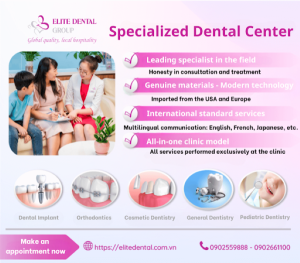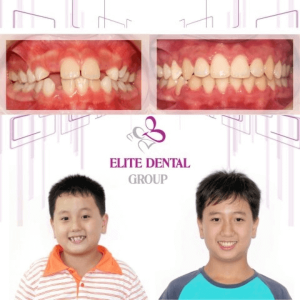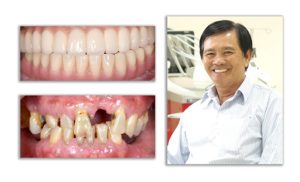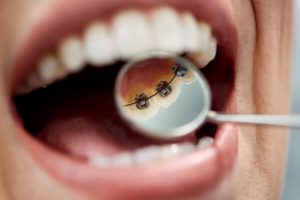Table of content
- 1. Do braces hurt, and how long does the discomfort last?
- 2. Which stage of braces is the most uncomfortable?
- 3. When do braces not hurt?
- 4. Choose Elite Dental – Start your braces journey without pain, with comfort and beautiful results
- 5. Tips from the Doctor to Reduce Pain and Discomfort During Braces Treatment
- 6. Frequently Asked Questions
1. Do braces hurt, and how long does the discomfort last?
Braces are a popular orthodontic solution to improve dental alignment, giving patients a straight, aligned smile and an ideal bite. During the process, your orthodontist will use various appliances, such as brackets, archwires, or clear aligners, to gently guide your teeth into the correct positions. This treatment doesn’t involve any invasive work on the jawbone or gums, so it generally doesn’t cause severe pain—except in special cases where a minor surgical procedure may be needed for impacted teeth.
So, if you’re wondering, “do braces hurt?” the answer is that any discomfort is usually limited to a sense of tightness or mild soreness, as the appliances apply gentle pressure to shift the teeth. This initial discomfort is temporary, often lasting only a few days as your teeth start to adapt to the new alignment process.

2. Which stage of braces is the most uncomfortable?
The braces journey has multiple stages, and each stage can bring different sensations. Here’s a closer look at what to expect at each phase:
2.1. General treatment stage
To ensure your teeth and gums are healthy before beginning orthodontic treatment, your dentist will conduct a thorough examination and address any existing dental issues, such as gingivitis, cavities, or periodontal concerns. Some patients may feel minor soreness or sensitivity after these preliminary treatments, but if your oral health is in good shape, you may skip this stage.
2.2. Spacer placement stage
The spacer stage involves placing small rubber bands, around 2mm thick, between certain teeth for about 5–7 days to create the necessary space for braces. Some patients describe a feeling of tightness, mild soreness, or discomfort while chewing, as well as a sensation of food getting trapped between teeth. Fortunately, this phase only lasts a few days, with discomfort fading as the teeth adjust.
2.3. Bracket and archwire placement stage
When the brackets and archwires are first placed, it may feel strange or uncomfortable as your cheeks, lips, and gums adjust to the new fixtures. You might notice some soreness or tenderness when eating or talking, but this sensation usually eases within a week or two as your mouth adapts.
2.4. Tooth extraction stage for space creation
For some patients, extractions are necessary to create space for aligning crowded or misaligned teeth. While the idea of extraction can sound intimidating, any discomfort is typically mild and manageable, with only slight swelling or tenderness at the extraction site that usually subsides within 3–5 days.
2.5. Regular tightening stage
Every 4–6 weeks, you’ll have follow-up appointments for your orthodontist to check your progress, adjust the archwires, and tighten the braces. This tightening process helps guide the teeth towards their final positions. While some patients may experience mild soreness, soft foods like soup or porridge are usually enough to make this stage more comfortable.
2.6. Conclusion: which stage of braces is the most uncomfortable?
Overall, the first few days after having the brackets and wires put on tend to be the most uncomfortable part of the braces journey. During this initial stage, your cheeks, lips, and gums are adjusting to the new appliances, which can cause mild soreness or irritation. However, this discomfort varies from person to person and generally fades quickly, so there’s no need for significant worry. Most patients find they adapt well and are comfortable throughout the remainder of their orthodontic treatment.
Factors affecting discomfort during braces treatment
Many people share on social media that they feel soreness and difficulty chewing while wearing braces. These experiences may stem from:
- Outdated techniques and equipment: In earlier days, orthodontic techniques were limited, and equipment was less advanced. Orthodontists often used thicker wires with strong force, especially with the initial wires, causing significant tooth rotation, which led to discomfort and pain.
- Unreliable dental clinics: Receiving braces treatment at a clinic with outdated equipment, inexperienced orthodontists, or unusually low costs can also lead to unnecessary pain and discomfort.
Currently, many dental clinics are appearing, especially in large cities like Ho Chi Minh City. However, which ones are truly quality providers, and how can you determine if a dental clinic is trustworthy? Join Elite Dental as we explore the 7 criteria for selecting a reputable dental clinic in Ho…
Therefore, you don’t need to worry too much about pain when wearing braces. The most important factor is to choose a reputable clinic with experienced orthodontists who have successfully treated many cases. A well-equipped clinic with advanced technology can not only minimize pain but also ensure a more comfortable, effective, and risk-free experience.
3. When do braces not hurt?
Generally, patients experience minimal discomfort if the following factors are in place:
3.1. Strong and healthy bone structure
If your dental bone structure is healthy and strong, you’re less likely to feel discomfort during braces treatment. Pain typically arises only when the bone structure is weak and unable to withstand the pressure from the braces.
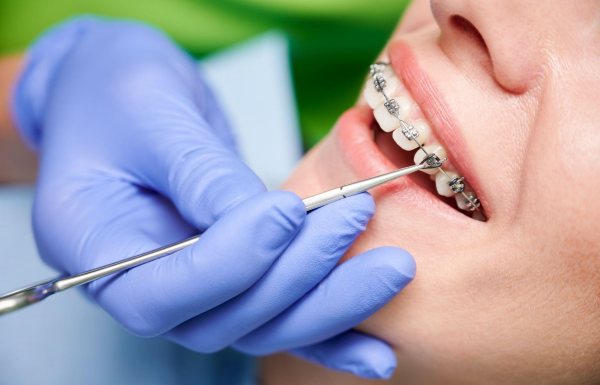
3.2. Experienced and compassionate orthodontist
Choosing a skilled orthodontist with years of experience and an understanding approach is crucial. Such a professional can accurately assess each patient’s pain tolerance and tailor the treatment plan to minimize discomfort while achieving optimal results.
3.3. Advanced equipment
To ensure a safe, effective braces process, patients should prioritize clinics equipped with advanced orthodontic technology, such as 3D Trios scanners, Clincheck software, and Sirona imaging systems from Germany. Conversely, using outdated equipment at less reputable clinics may lead to increased discomfort during treatment.
3.4. Appropriate braces method
The level of discomfort during braces treatment can also depend on the type of braces chosen. Traditional braces with elastics often cause friction due to the stretching of elastics in the brackets, leading to soreness. However, self-ligating braces distribute the force more evenly, reducing discomfort.
With modern options, braces treatment has become more comfortable. Invisalign clear aligners offer a discreet, gentle alternative for all ages. Instead of using wires and brackets, Invisalign employs a series of transparent aligners made from special biocompatible plastic. Customized for each individual, they are easy to remove, provide optimal tooth movement, and offer a comfortable, effective orthodontic experience.
4. Choose Elite Dental – Start your braces journey without pain, with comfort and beautiful results
Elite Dental is a specialized orthodontic clinic with over 12 years of experience. When you choose Elite Dental, you can be confident in a braces process that’s effective, safe, and minimizes discomfort thanks to these outstanding advantages:
- The team of specialized orthodontists at Elite Dental has extensive experience and carefully designs treatment plans tailored to each patient’s specific dental alignment and bite issues. Our doctors not only possess advanced expertise but also deeply understand the psychological needs of our patients, closely monitoring their discomfort levels to provide timely support.

- The braces process at Elite is meticulously structured, safe, and customized to your dental condition. Elite Dental’s orthodontists perform orthodontic adjustments with precision and care, strictly adhering to sterilization protocols to prevent any unnecessary discomfort.
- Elite offers a variety of orthodontic options, including metal braces, ceramic braces, Meaw archwires, and clear aligners. Additionally, we ensure the use of FDA-certified wires and brackets that are safe for your health. Our clear aligners are made from FDA-approved biocompatible plastic, free from any side effects or allergies.
- We utilize state-of-the-art equipment, such as 3D Trios scanning, Clincheck software, and Sirona imaging from Germany, to facilitate a smooth and effective braces treatment process with optimal results. Our clinic operates on an “ALL IN 1 CLINIC” model, allowing patients to complete all steps—consultation, X-ray imaging, treatment, etc.—at the same facility without needing to move between locations.
5. Tips from the Doctor to Reduce Pain and Discomfort During Braces Treatment
To alleviate discomfort during your braces journey, here are a few helpful tips:
- Rinse with salt water to reduce pain and disinfect wounds, especially if braces cause mouth sores or ulcers from rubbing against the brackets.
- Use a soft-bristled toothbrush to maintain oral hygiene. Pair it with flossing after meals and rinsing with saline solution.
- Take pain relievers if necessary to ease pain quickly, but make sure to consult your doctor about the correct dosage and frequency.
- Stick to soft foods like steamed dishes, porridge, soups, and yogurt. Avoid extremely hot, cold, or hard foods while wearing braces.
- Apply dental wax to brackets that rub against the cheeks, gums, or lips to minimize irritation and discomfort.
6. Frequently Asked Questions
Many patients have common concerns regarding discomfort during braces treatment:
6.1 Do braces hurt when first attached?
The answer is no. However, you may feel some initial discomfort or irritation as you adjust to the brackets, which may rub against the inner cheeks and lips, causing some annoyance while eating or speaking. This discomfort typically lasts only 1–2 weeks as your body adapts.
6.2 Do children feel pain when getting braces?
Yes, but only mildly. When children receive braces at an early age, typically between 5 and 11 years old when the jaw is still developing and more flexible, they may only feel slight discomfort during adjustments, which quickly subsides.
6.3 Do clear aligners cause pain?
Unlike traditional braces, clear aligners use finely trimmed trays that avoid gum irritation. The force applied to move the teeth is gentler than the force from brackets and wires. Therefore, depending on each person’s pain threshold, aligners may cause only mild discomfort for a few days, and some may feel almost no discomfort at all.
6.4 Does removing braces hurt?
Removing braces does not cause pain. The process simply involves the dentist detaching the brackets and wires, which does not harm the teeth or surrounding areas, so there’s no need to worry.
The above information addresses common concerns about pain during braces treatment. The journey of wearing braces can last for several years, so to have a comfortable, pain-free experience, it’s essential to choose a reputable dental clinic and experienced orthodontist.
>> Book your braces appointment with Elite Dental today for a comfortable, pain-free orthodontic journey, and get ready to achieve a confident, radiant smile!


